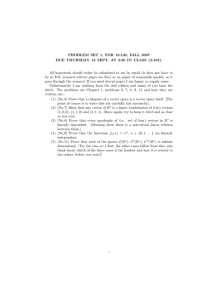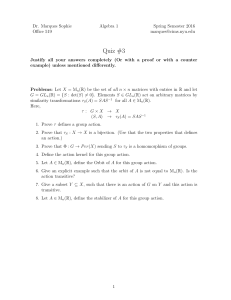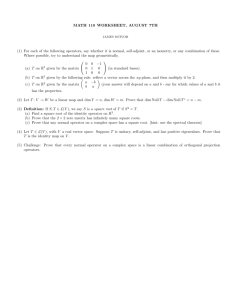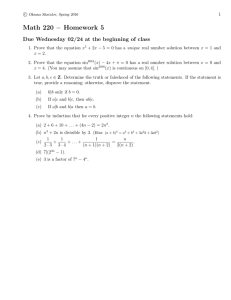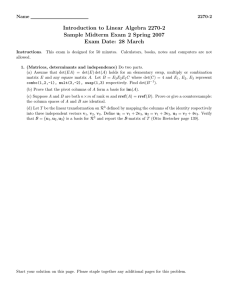Hand in problems#3
advertisement
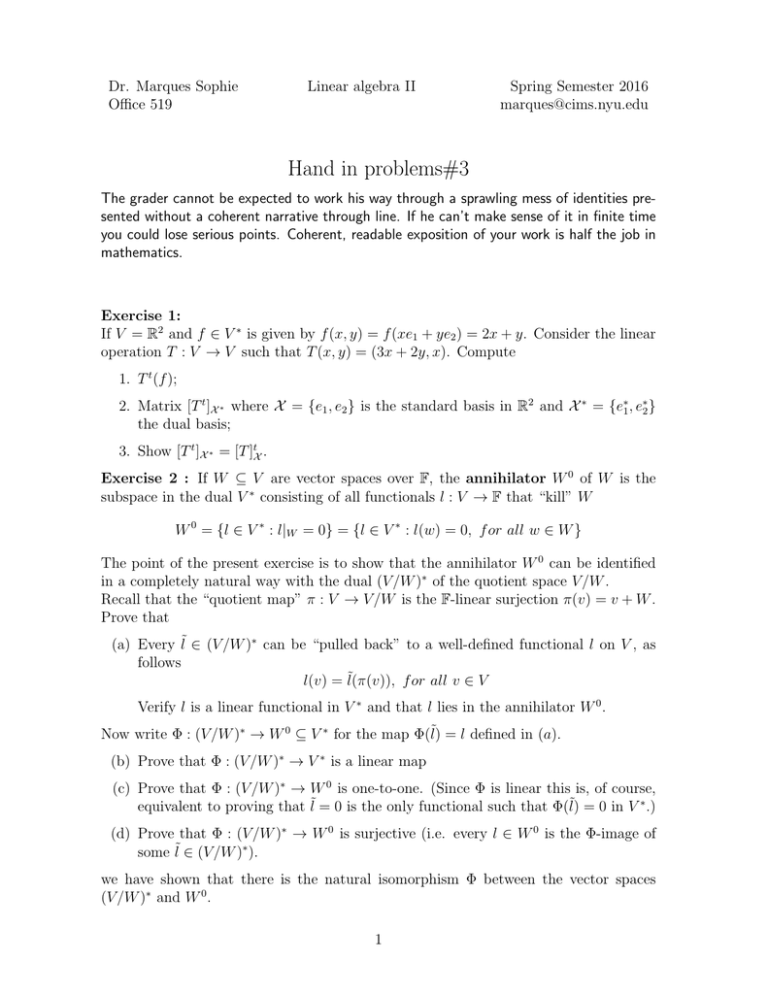
Dr. Marques Sophie
Office 519
Linear algebra II
Spring Semester 2016
marques@cims.nyu.edu
Hand in problems#3
The grader cannot be expected to work his way through a sprawling mess of identities presented without a coherent narrative through line. If he can’t make sense of it in finite time
you could lose serious points. Coherent, readable exposition of your work is half the job in
mathematics.
Exercise 1:
If V = R2 and f ∈ V ∗ is given by f (x, y) = f (xe1 + ye2 ) = 2x + y. Consider the linear
operation T : V → V such that T (x, y) = (3x + 2y, x). Compute
1. T t (f );
2. Matrix [T t ]X ∗ where X = {e1 , e2 } is the standard basis in R2 and X ∗ = {e∗1 , e∗2 }
the dual basis;
3. Show [T t ]X ∗ = [T ]tX .
Exercise 2 : If W ⊆ V are vector spaces over F, the annihilator W 0 of W is the
subspace in the dual V ∗ consisting of all functionals l : V → F that “kill” W
W 0 = {l ∈ V ∗ : l|W = 0} = {l ∈ V ∗ : l(w) = 0, f or all w ∈ W }
The point of the present exercise is to show that the annihilator W 0 can be identified
in a completely natural way with the dual (V /W )∗ of the quotient space V /W .
Recall that the “quotient map” π : V → V /W is the F-linear surjection π(v) = v + W .
Prove that
(a) Every ˜l ∈ (V /W )∗ can be “pulled back” to a well-defined functional l on V , as
follows
l(v) = ˜l(π(v)), f or all v ∈ V
Verify l is a linear functional in V ∗ and that l lies in the annihilator W 0 .
Now write Φ : (V /W )∗ → W 0 ⊆ V ∗ for the map Φ(˜l) = l defined in (a).
(b) Prove that Φ : (V /W )∗ → V ∗ is a linear map
(c) Prove that Φ : (V /W )∗ → W 0 is one-to-one. (Since Φ is linear this is, of course,
equivalent to proving that ˜l = 0 is the only functional such that Φ(˜l) = 0 in V ∗ .)
(d) Prove that Φ : (V /W )∗ → W 0 is surjective (i.e. every l ∈ W 0 is the Φ-image of
some ˜l ∈ (V /W )∗ ).
we have shown that there is the natural isomorphism Φ between the vector spaces
(V /W )∗ and W 0 .
1
Exercise 3:
If A is an n × n matrix and Fn is given the standard inner product, prove that
LA∗ = (LA )∗ as operators on Fn .
Exercise 4: If a finite dimensional vector space is a direct sum V = E ⊕ F and
PE , PF = I − PE are the associated projections onto E and F , prove that a linear
operator T : V → V leaves both subspaces E, F invariant if and only if T commutes
with PE (hence also PF ).
Exercise 5:
Let W ⊆ V be finite dimensional vector spaces over F. Let X = {e1 , · · · , em } be any
basis for the subspace W and let
X = {f¯1 , · · · , f¯n }
be any basis for the quotient space V /W . If we select any preimages f1 , · · · , fn in V
so that f¯j = fj + W in V /W for each j, prove that the {fj } are linearly independent
vectors in V , and that
{e1 , · · · , em , f1 , · · · , fn }
is always a basis for the vector space V .
Note: This is one way to prove that dim(W ) + dim(V /W ) = dim(V ).
Exercise 6:
Prove that
1. Every n×n matrix can be written as a linear combination of matrices in GL(n, F).
2. If a matrix A commutes with all matrices B ∈ M (n, F), then A must be scalar,
i.e. A = diag(λ, · · · , λ) for some λ ∈ F.
3. A matrix A has a one-point similarity class if and only if
SAS −1 = A f or all S ∈ GL(n, F)
Prove that this happens precisely when A = λI for some λ ∈ F.
Hint: Part 2. is the most important fact; do this even if you have trouble with 1.; in
2. try some really simple choices for B ∈ M (n, F) and see what AB − BA = 0 tells you
about A.
Note: We have identified the center of the matrix algebra M (n, F), the set of matrices
A that commute with all n × n matrices. They are all scalar.
Exercise 7:
If dim(V ) = 2 and T : V → V is any linear operator, its characteristic polynomial
pT (λ) ∈ F[λ] has the form
pT (λ) = λ2 − T r(T )λ + det(T )
2
Question: If A, B ∈ M (2, F) such that det(A) = det(B) and T r(A) = T r(B), is there
an S ∈ GL(2, F) such that B = SAS −1 ?
Hint: Try some upper triangular 2 × 2 matrices.
3
